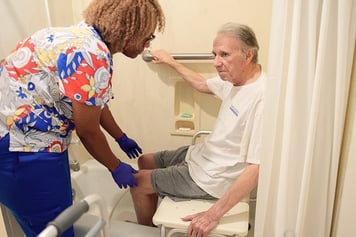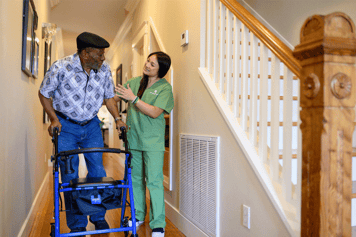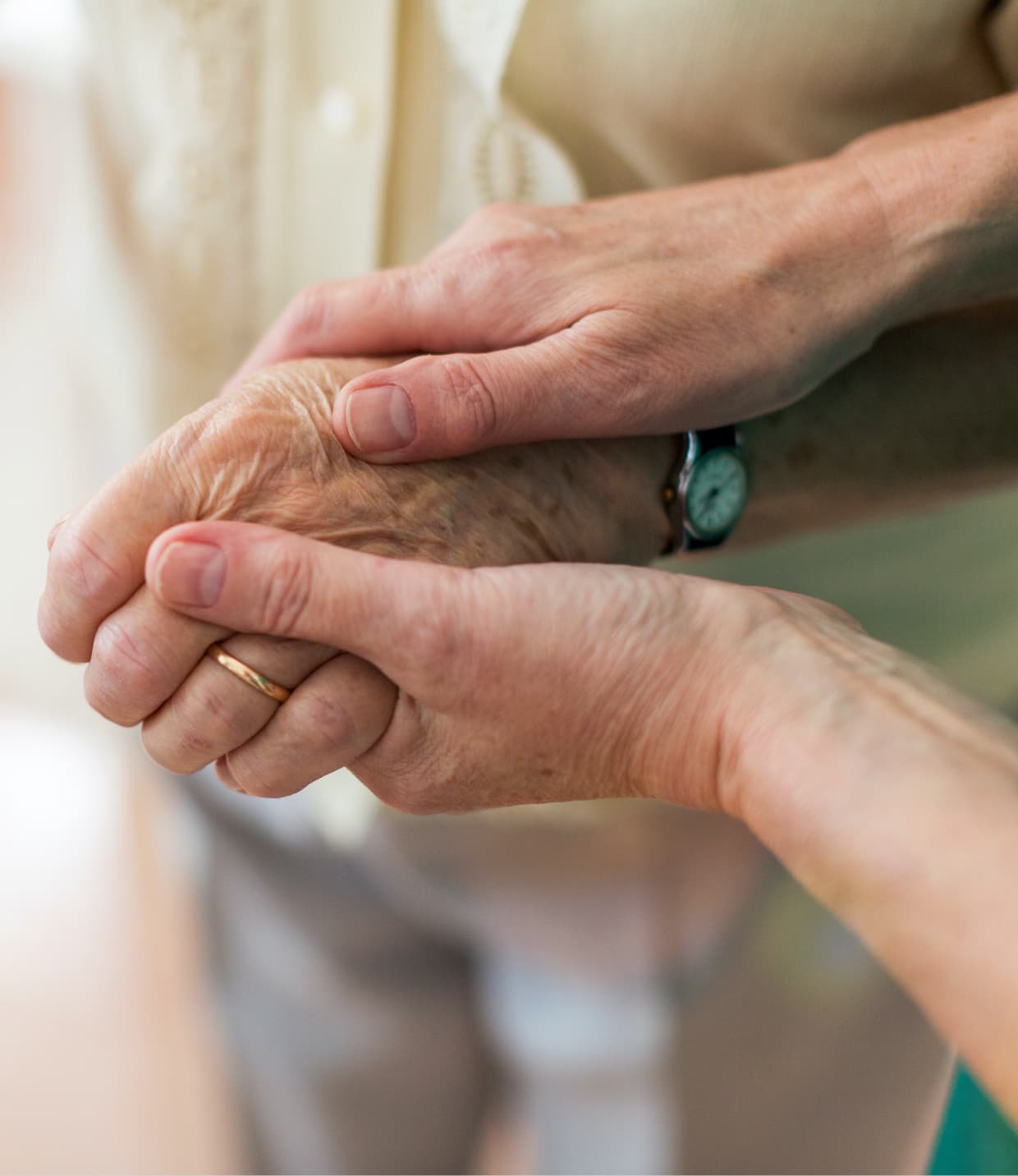Fall prevention for patients is a critical priority across the continuum of care. In the hospital or inpatient clinic, fall reduction strategies are in place to help reduce the risk of injury. But what about when a patient returns home to recover with home health care support? We already know that millions of older adults fall at home each year. How can home health help ensure your patients are safe in their home environment?
In this article, we’ll take a closer look at the importance of fall prevention programs in home health, and how these initiatives can and should be a priority in home health care delivery. We’ll also consider what key elements you should look for in a home health fall prevention program as a referring provider.
Understanding Fall Prevention Programs
More than 30% of adults aged 65 and older fall each year, and around 10% of those falls result in serious injury. 1 Overall, falls remain the leading cause of both injury and injury-related deaths in this age group. 2
Federal initiatives have been launched to reduce this risk, such as the Centers for Disease Control and Prevention (CDC) Stopping Elderly Accidents, Deaths and Injuries (STEADI) initiative and Centers for Medicare and Medicaid (CMS) no-pay policy which withholds reimbursement to hospitals for costs related to inpatient falls.
The healthcare industry has taken a variety of actions to join in these efforts to reduce falls with injury for patients, including the adoption of formal fall prevention programs in hospitals and other healthcare facilities. As outlined by STEADI, effective fall prevention strategies include three vital steps: screen, assess and intervene.
Screening for Fall Risk
To help determine whether specific interventions are necessary to help reduce fall risk, all patients should be routinely screened for their individual risk of falls. Standardized tools can help support this, such as STEADI’s 12-question Stay Independent tool. Patients at increased risk of falls include those with these factors: 3
- History of previous falls
- Impaired balance
- Vision impairment
- Hearing impairment
- Polypharmacy
- Reduced muscle strength
- Cognitive impairment
- Gait difficulty
- Depression
- Orthostasis or dizziness
- Age > 80
- Female
- Incontinence
- Chronic medical problems including diabetes, arthritis and pain
With four of these risk factors, the 1-year risk of falling increases by 78%, from 8% with no risk factors. 4
Assessing Patients for Modifiable Fall Risk Factors
If a patient screens as “at risk” for falls, a more in-depth assessment of fall risk factors is indicated. The STEADI algorithm recommends the following approach for assessment: 5
- Evaluate balance, gait and strength with assessments such as Timed Up and Go and the 4-Stage Balance Test
- Ask about potential hazards at home
- Identify any medications that could increase fall risk
- Review medical history for comorbidities
- Check visual acuity
- Check hearing
- Assess feet and footwear for potential concerns
- Measure orthostatic blood pressure
- Ask about fall history and near-falls
Intervening to Reduce Falls
When fall risk is identified, several evidence-based steps can be taken to reduce risk in both the near-term and long term. For hospitalized patients, fall prevention programs include precautions like bed alarms, assistance with mobility and toileting, non-slip socks and mobility devices. In the community, home safety assessment and home modifications can create a less risky environment. Additionally, custom interventions should be part of the patient’s care plan, including: 6
- Collaborate with the pharmacist to adjust medications when possible to minimize or eliminate doses that elevate fall risk or adjust the timing of medications to reduce the impact on fall risk (e.g. antihypertensives / diuretics)
- Refer patients to physical therapy and occupational therapy
- Encourage appropriate exercise to increase strength and endurance
- Address vision and hearing impairments
- Support foot health and proper footwear with education and podiatry referral if appropriate
- Address orthostatic hypotension with medication changes and patient education
[action 1]
Key Elements of an Effective Fall Prevention Program in Home Health
When patients are discharged home for care, it’s important to know if their home health care provider has a structured fall prevention program in place to address fall risks. Not only do home health care providers have a unique opportunity to assess a patient’s environment in real time, but their frequent patient interactions may also often represent the best chance to intervene before a problem becomes worse.
A home health fall reduction program should offer these key elements:
Home Safety Assessment and Modifications
Professional home safety assessments can help uncover risk factors in the home, including slippery or uneven surfaces, inadequate lighting, trip hazards, inappropriate footwear, improper use of assistive devices, missing stair handrails and more.
By removing hazards and introducing strategies like non-slip mats, grab bars in the bathroom, improved lighting and other safety measures, fall risk is reduced.
Patient Education Tailored to Fall Risk Reduction
By working with patients to educate them on common risks and develop habits to reduce falls, home health care providers can customize patient teaching to the environment. Staff should have training in effective and practical approaches patients can take to minimize risk. Teaching patients to keep frequently used items close by, use assistive devices properly and maintain proper hydration and blood pressure are some of the strategies to help.
Targeted Interdisciplinary Interventions to Prevent Falls
Multiple specialties can address fall risk at home, including physical therapy, occupational therapy, skilled nursing, speech-language pathology, home health aides and medical social workers. In developing fall reduction strategies at home, each have a designated role in providing support to patients.
Protocols to Address New Falls
Even with the best fall prevention interventions, falls can happen. Does the home health agency have processes or resources in place to alert them to a new fall and/or summon emergency assistance quickly? Fall monitors in the home should be offered as part of a home health fall prevention program.
Fall Prevention Should be Part of Home Care
Amedisys recognizes the importance of fall prevention, not only in preventing avoidable injuries and hospital readmissions, but also in helping our patients maintain their independence safely at home for as long as possible.
That’s why we developed our home health Fall Reduction Program. We provide evidence-based clinical practices to reduce fall risk, backed by an interdisciplinary team that can address the STEADI goals of screen, assess and intervene in the home. We also offer a fall detection system for up to 120 days at no charge for patients on our service, which automatically sends an alert for help when a patient experiences a fall at home.
To learn more, contact us or refer a patient today.
Staci McGuire, DPT, MBA, serves as the Home Health Director of Clinical Strategy, Programs and Therapy Practice at Amedisys. With over 16 years of experience in various clinical roles within the organization, she is dedicated to empowering clinicians to provide exceptional care and achieve optimal patient outcomes by adhering to current best practices and standards of care.






